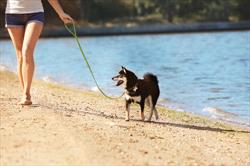Loose Leash Walking
When walking your dog, you can determine how loose leash walking works best for you. You may not have a right or left side preference, or desire to have your dog perfectly aligned with your leg. You may be okay with having them walk a few steps ahead of you. You may be perfectly happy as long as they are not pulling you.
If you decide that basic loose leash walking is more your speed than heeling, that is okay. Dogs that respond to their owner’s simple request on a walk are just as well behaved. When you try loose leash walking, carry items that your dog finds to be highly rewarding. In most instances, food is the best choice, but if your dog passes up food to play with a tennis ball or other toy, bring that along.
Loose Leash Walking Dog

Photo courtesy of Depositphotos
How to Teach Loose Leash Walking
One of the easiest ways to teach a dog to maintain a loose leash is by rewarding them when they do it accidentally. Once you feel your dog’s leash become loose on its own, make sure to reward them. If you reward them every time you discover them doing something you like, they will begin to offer it more frequently. If you find that you cannot get the treat to your dog fast enough, don’t worry. Consider using a clicker or verbal marker like “yes” in your training to help your dog identify those desirable behaviors.
What if you walk your dog and you never achieve a loose leash, even for a few steps?
- If the environment that you are walking in is too distracting, consider going to a different area.
- Allow your dog to burn off some energy by running and playing before you practice loose leash walking.
- Another easy solution is to change the time of day you head out. Going at non-peak times, early in the morning or late in the evening, gives you a better chance for success.
If these modifications still don’t give you the success that you hoped for, using a management walking tool is the next change to consider.
Walking Tools for Management
There is no shortage of loose leash walking devices available on the market. Each one promises to be better than the previous one. When selecting one, asking for help from a training or behavior professional will likely offer the best result. Set your dog up for success by using a tool that allows more opportunities for good behavior. Remember, your goal is to capture your dog being good. Tools such as a front-leading body harness or a head halter will help to maximize leash control and minimize discomfort. Avoid tools that cause pain, discomfort, or fear. Tools that inflict shock, mild vibration, cause pain on sensitive organs, or cut off oxygen supply for even short periods may interrupt behaviors you do not like, but will likely cause other problematic behaviors.
Look at the world from your dog’s perspective. The less often you go for walks, the more novel and exciting it will be when they get the opportunity to explore. Try to understand their excitement. Be sure to make the walk equally as enjoyable for them as it is for you. Be kind and fair in your training methods, and always make time for a few good smells.